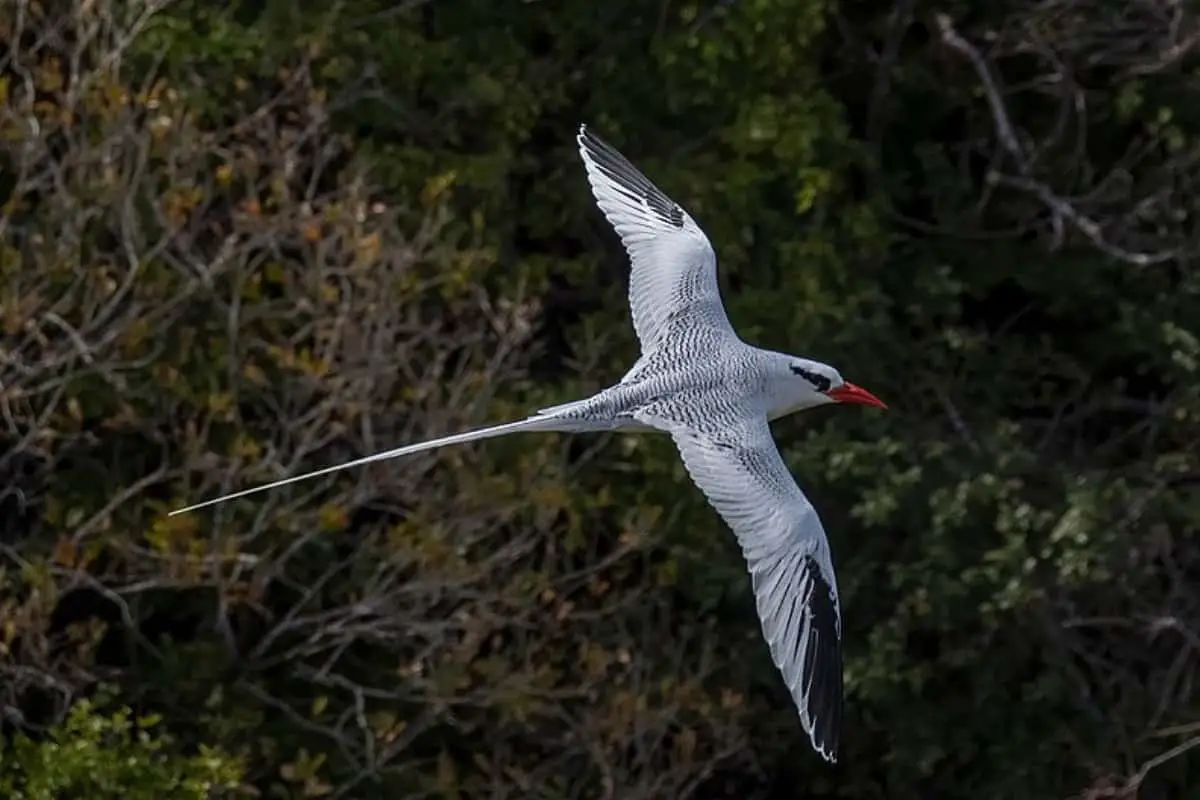Common Name: Red-billed Tropicbird
Scientific Name: (Phaethon aethereus)| Size | Diet | Range in Hawaii | Status in Hawaii |
|---|---|---|---|
| 38 in. - 43 in. | fish and squid | O'ahu and Kaua'i | Least Concern |
The Red-billed Tropicbird (Phaethon aethereus) is a stunning and elegant seabird that is known for its long, red bill and distinctive tail feathers. With its graceful flight and striking appearance, this tropicbird is a fascinating sight in its natural habitat.
Although it is not a native species to Hawaii, Red-billed Tropicbirds have been spotted occasionally on the islands as non-breeding visitors, known locally as the Koa’e ‘ula. In this article, we’ll explore the fascinating world of the Red-billed Tropicbird and learn more about its occasional presence in Hawaii.
Red-billed Tropicbird
Appearance

The Red-billed Tropicbird is a striking seabird with a distinctive appearance. It has a white body, long, narrow wings, and a deeply forked tail.
The most notable feature of the Red-billed Tropicbird is its bright red bill, which contrasts beautifully against its white plumage. The bill is long and slender, with a slightly curved shape. The bird’s eyes are also surrounded by black markings, adding to its striking appearance.
In terms of size, the Red-billed Tropicbird measures approximately 38 to 43 inches (96 to 109 cm) in length from the tip of its bill to the end of its tail. Its wingspan can reach up to 47 to 51 inches (120 to 130 cm). This species exhibits sexual dimorphism, with males and females having similar appearances, making it challenging to distinguish between the sexes based on physical characteristics alone.
Diet
The diet of the Red-billed Tropicbird primarily consists of fish and squid. As a seabird, it is well adapted to catching prey from the ocean surface. The tropicbird uses its keen eyesight to spot fish swimming near the water’s surface. It then dives from the air, plunging into the water to capture its prey.
The Red-billed Tropicbird is an agile and skilled hunter. It can dive from considerable heights and reach impressive speeds as it descends towards the water. Once underwater, it uses its sharp, pointed bill to snatch fish or squid. It mainly feeds on small pelagic fish, such as flying fish and mackerel, but its diet may also include other marine organisms found near the surface.
This species is known for its aerial foraging behavior, where it can hover over the water or glide low above the waves, searching for prey. It has been observed feeding individually or in small groups, especially during the breeding season when both parents are involved in provisioning their chicks.
Nesting
The Red-billed Tropicbird is a species known for its unique nesting behavior. It typically nests on remote islands, rocky cliffs, or in dense vegetation. The nesting season varies depending on the location, but it generally occurs between the months of May and September.
The tropicbird constructs its nest using materials such as twigs, grass, leaves, and other vegetation. The nest is usually a shallow scrape or a small platform built on the ground, in crevices, or on cliffs. The female typically lays a single egg, which is incubated by both parents. The incubation period lasts for about 40 to 46 days.
Both the male and female take turns incubating the egg and caring for the chick after it hatches. They provide food for the chick by going out to sea and catching fish and squid. The chick grows rapidly and develops flight feathers in about 10 to 12 weeks. During this time, the parents continue to feed and protect their offspring.
Once the chick is fully grown and capable of flight, it leaves the nest and becomes independent. The Red-billed Tropicbird may return to the same nesting site each year or find a new location for nesting. They are generally solitary nesters, although multiple nests may be found in close proximity on suitable nesting sites.
Behavior

The Red-billed Tropicbird exhibits a range of captivating behaviors that highlight its unique nature. These birds are exceptional flyers, effortlessly soaring through the air with their long, slender wings and streamlined bodies.
Their flight is characterized by graceful glides, dramatic swoops, and impressive aerial acrobatics, often accompanied by their trailing long tail streamers. Vocalizations play an important role in their behavior, with piercing calls and sharp, high-pitched screams used for communication, such as attracting mates or signaling alarm.
When it comes to feeding, Red-billed Tropicbirds showcase their piscivorous nature, meaning they primarily feed on fish. Employing a remarkable technique known as plunge-diving, they spot their prey from high above the water and dive straight down, plunging into the depths to catch fish with their hooked bills. Their agility as swimmers allows them to swim underwater to capture their prey as well.
During the breeding season, Red-billed Tropicbirds engage in elaborate courtship displays. They perform aerial feats, soaring high in the sky, circling, and diving in synchronized patterns. These displays, coupled with bill dueling and vibrant plumage, serve to attract potential mates.
Nesting behavior is another fascinating aspect of their behavior. These birds nest in remote locations, often on rocky cliffs or islands, constructing nests using twigs, grass, leaves, and other materials. Both the male and female participate in incubating the egg and caring for the chick once it hatches, displaying dedicated parental care by providing food and protection until the chick becomes independent.
Migration is a notable behavior of the Red-billed Tropicbird. They undertake long-distance migrations, traveling between breeding and non-breeding areas. Some populations embark on arduous journeys, crossing vast oceans and covering thousands of miles to reach their destinations.
Habitat
The Red-billed Tropicbird occupies a range of diverse habitats in its tropical and subtropical distribution. These birds are commonly found in coastal areas, including rocky cliffs, offshore islands, and coral atolls. They have a preference for nesting in remote and inaccessible locations, often choosing steep cliffs or islets that offer protection from ground predators. These habitats provide the necessary seclusion and safety for breeding and rearing their young.
The subtropical and tropical regions of the Eastern Pacific, Atlantic, and Indian Oceans are the primary range of the Red-billed Tropicbird. They can be found in a variety of island environments, including tropical rainforests, coastal shrublands, and sandy beaches. These birds have adapted well to coastal environments and rely on the ocean for their survival, both for feeding and dispersal during migration.
Range
The Red-billed Tropicbird is not regularly found in the Hawaiian Islands. Its primary range is in the subtropical and tropical Eastern Pacific, Atlantic, and Indian Oceans. However, there have been occasional records of Red-billed Tropicbirds as vagrants in Hawaii.
These sightings have been sporadic and scattered throughout the islands. Some of the notable locations where Red-billed Tropicbirds have been observed in Hawaii include Nihoa Island, French Frigate Shoals, Kilauea Point on Kaua’i, and the rocky southeast coast of O’ahu.
While their presence in Hawaii is uncommon, these sightings provide valuable opportunities to observe this beautiful tropical seabird outside of its typical range.
Conservation Status

The Red-billed Tropicbird is classified as a species of “Least Concern” by the International Union for Conservation of Nature (IUCN). This indicates that the species is not currently facing a high risk of extinction.
Interesting Facts
1. Acrobatic flight
These birds are highly skilled flyers, capable of impressive aerial maneuvers. They have long, slender wings that allow them to soar gracefully and perform acrobatic displays, including swooping, diving, and hovering above the water.
2. Fish-based diet
The diet of the Red-billed Tropicbird consists mainly of fish. They are skilled divers and plunge into the water from flight to catch their prey. They primarily feed on small fish species, including flying fish, anchovies, and sardines.
3. Nomadic lifestyle
Red-billed Tropicbirds are considered nomadic, often traveling long distances in search of suitable breeding and foraging sites. They can be found in different regions of the world, including the Eastern Pacific, Atlantic, and Indian Oceans, as well as the subtropical and tropical areas.
4. Unique courtship display
During courtship, male Red-billed Tropicbirds engage in an elaborate display to attract females. They will fly high in the air, descending in a zigzag pattern while calling loudly. This display showcases their agility and beauty and is a remarkable sight to behold.
5. Striking appearance
The Red-billed Tropicbird is known for its stunning appearance. It has a white body, elongated central tail feathers that trail behind, and a bright red bill, which gives it its name. This combination of colors makes it a visually striking bird.
Frequently Asked Questions
1. Can I see Red-billed Tropicbirds in captivity?
Red-billed Tropicbirds are not commonly found in captivity, as they have specific habitat and dietary requirements that are challenging to replicate. Conservation efforts primarily focus on protecting their natural habitats rather than keeping them in captivity.
2. How long do Red-billed Tropicbirds live?
The lifespan of Red-billed Tropicbirds in the wild is estimated to be around 10 to 15 years. However, with proper conservation measures and protection of their habitats, some individuals may live longer.
3. Are Red-billed Tropicbirds social birds?
Red-billed Tropicbirds are generally solitary birds outside of the breeding season. However, they can congregate in large numbers at certain feeding areas or nesting colonies, where they may interact with other individuals.
4. How do Red-billed Tropicbirds communicate?
Red-billed Tropicbirds use vocalizations for communication. They have a variety of calls, including squawks, screeches, and whistles. These vocalizations are often used during courtship displays and territorial interactions.




